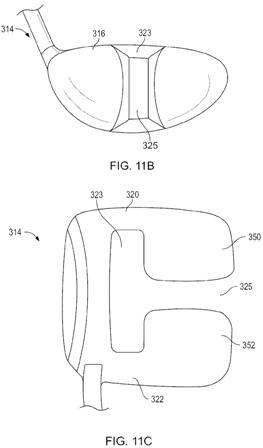More from Nike… the T-Bone (or Hollow Point) Driver
Earlier this week I posted (HERE ) about a new Nike design that I initially thought was a putter and turned out to be a driver. Well this week a related patent application published that throws a few more wild designs in the mix. Check them out!
The drawings come from US Pub. No. 20100190573, which explains:
Dave Dawsey - Monitoring Golf Patent Applications
The drawings come from US Pub. No. 20100190573, which explains:
I guess the old Bullet Golf “Hollow Point” from the 1990’s was ahead of its time![0078] FIGS. 11A-11C illustrate another alternate arrangement of a golf club head 314 according to aspects described herein. The golf club head 314 includes a golf club head body 316. The golf club head body 316 generally includes a toe portion 330, a heel portion 332, a front face 334 and a rear portion 336. As shown in FIG. 11A, a portion of the golf club head body 316 is removed and a void 323 is created within the remainder of the golf club head 314 and defined by the remainder of the golf club head 314. This removal of a portion of the golf club head body 316 aids in reducing weight associated with the golf club head 314. In addition, removing weight at or near a center of the club head body 316 aids in distributing weight to the rear and/or outer perimeter of the golf club head 314 in order to provide improved performance characteristics. It is understood that the golf club head body 316 of FIGS. 11A-11C may be a solid construction or a hollow construction as desired.
[0079] As shown in FIG. 11A, as well as the rear view shown in FIG. 11B and the top view of FIG. 11C, the rear portion 336 of the golf club head 314 includes an opening 325 extending through the golf club head body 316. In some arrangements, the opening 325 may be between 1 and 4 inches wide. The opening 325 may extend from the edge of the rear portion 336 and into a central region 327 of the golf club head body 316 in order to reduce weight associated with the central region 327 of the golf club head body 316. The opening 325 is thus in communication with and may be considered part of the void 323. In some arrangements, the void 323 formed in the golf club head body 316 may form a T-shape. That is, the opening 325 may extend into the central region 327 of the golf club head body 316 and then communicate with an opening that extends toward the toe portion 330 and heel portion 332 of the golf club head 314. In such a configuration as shown in FIG. 11A, the void 323 is generally T-shaped. As further shown in FIGS. 11A-11C, the golf club head 314 has a first arm 320 and a second arm 322 that extend rearwardly from the front face 334 of the club. At a distal end or free end of the first arm 320, the first arm 320 has a first inwardly extending member 350. Similarly, at a distal end or free end of the second arm 322, the second arm 322 has a second inwardly extending member 352. The first inwardly extending member 350 and the second inwardly extending member 352 are spaced from one another and positioned in confronting relation wherein the opening 325 is defined between the members 350, 352. This arrangement aids in distributing weight associated with the golf club head 314 to the perimeter of the golf club head 314 and, additionally, toward the rear and/or rear corners of the golf club head.
[0080] In some examples, the weight associated with the portion of the golf club head removed to form the void may be between 15 g and 50 g. In still other examples, the amount of material removed to form the void may comprise 5% to 30% of the area or mass of the club head.
Dave Dawsey - Monitoring Golf Patent Applications




Comments